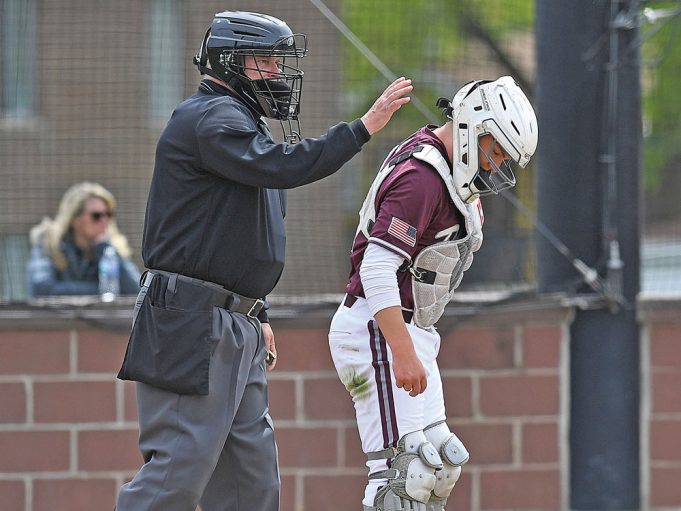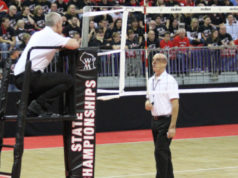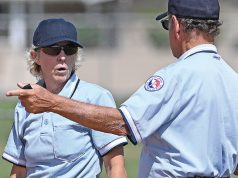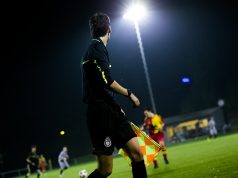A
t a time when scrutiny of officials is greater than ever before, the need to get plays right is Job One. Most evaluators won’t judge too harshly an official who may not be in the absolute best position according to the manual but still makes a correct ruling on the play. Unless the official freelances his or her positioning the entire game, judgment trumps mechanics almost every time.
With all of the pressure officials face while play is in progress, it’s easy to forget what happens while play is stopped is just as important as what happens during active play. An official who views timeouts or the time between plays as dead time is asking for trouble. Preparing for what will or may happen next helps officials maintain game control and puts them in a frame of mind to cover the action that follows.
Here are six things you need to do before play resumes after a stoppage.
1. Make eye contact with your partners
Just because you’re ready to go, it doesn’t mean those you’re working with are in the same state of preparedness. They may be tying a shoe, addressing a clock or equipment problem, talking to a coach or player or just plain daydreaming. Restarting the game before everyone’s ready can result in having to redo the restart, which makes you look less than professional.
You should also make sure game-related auxiliary personnel (e.g. the chain crew, scorers, timers) are in place and ready to go as well.
2. Consider the game situation
Understanding what strategy the teams may employ helps you plot your positioning ahead of time. The score, juncture of the game and other factors should all be noted and analyzed. Will the offense throw a long pass? Will the trailing team pull the goaltender? Could a double steal be coming?
In addition to strategies, knowing which rules may come into play when the action resumes will prevent you from being surprised when a situation arises. How many free throws are awarded and how is play resumed after an intentional foul? What are the receiving team’s options if the kicking team touches an onside kick before it goes 10 yards?
3. Check for obstacles or other potential dangers
Cheerleaders or dance teams using props such as pompoms or run-through banners sometimes leave debris behind on the playing surface. Make a quick but thorough visual scan of the area to be sure it’s safe to proceed.
Fans anticipating the end of the game will sometimes move closer to the court or field. If necessary, get the help of game management to keep the spectators back so they don’t become entangled with athletes or officials and don’t interfere with play.
If the game was stopped because a player was bleeding, be sure any affected areas are properly cleaned.
Ensure that game apparatus (e.g. nets, pylons, goals) is in order. Teams should be sure that warmup baseballs and softballs have been gathered up from the field and that the team now on defense has removed items from its on-deck area.
If a player goes down to the floor, sweat may be transferred to the playing surface. Ensure that is removed with a towel or mop.
Water or sports drinks that spill in the bench area after timeouts also need to be cleaned up.
4. Count the players
Don’t allow a team to put itself at a disadvantage by restarting play with fewer than the required number of players.
By the same token, if the rules of the game allow you to help a team correct a situation in which it has too many players, take advantage of the rule. That is preventive officiating, not coaching.
5. Know the clock status
In sports that use a game clock, know if and when the game clock is supposed to start. If time incorrectly ran off the clock and you have positive knowledge of how much time was involved, have that time put back on the clock. That is especially important at the end of periods when time is precious.
Sad to say, some clock operators are less than scrupulous. In some cases, particularly at lower levels, they are not well trained. If there are repeated timing errors, consider asking game management for a replacement or taking over timing duties yourself.
6. Observe injured players
If play was stopped because a player was injured, note if the player is attempting to return to the game. In some cases, the rules require that if play was stopped because of an injury, the player may not return to action immediately. If the injury is so severe that the rules require the player to receive written clearance from a physician before participating, you must obtain the document and keep it for your records.
If a player needs assistance getting off the court or field, don’t resume play until the player and any support staff have completely cleared the area.
When blood is involved, enforce whatever rules apply to your sport. If a player’s jersey is saturated with blood, that will entail having the player change uniforms. Be sure the player’s number is changed in the scorebook and the opposing team is notified to prevent any confusion.
What's Your Call? Leave a Comment:
Note: This article is archival in nature. Rules, interpretations, mechanics, philosophies and other information may or may not be correct for the current year.
This article is the copyright of ©Referee Enterprises, Inc., and may not be republished in whole or in part online, in print or in any capacity without expressed written permission from Referee. The article is made available for educational use by individuals.



















